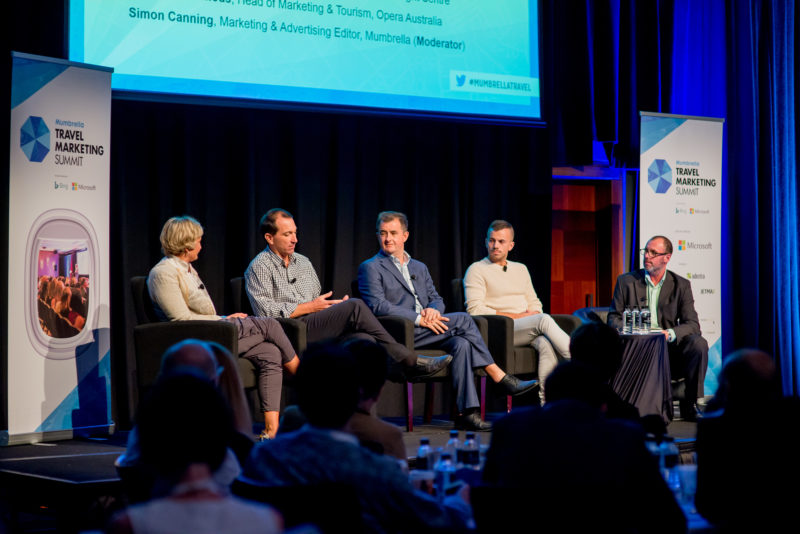‘Ease of use’ trumps loyalty in customer experience says Flight Centre marketer
Ease of use surrounding customer experience trumps loyalty in the travel industry, Flight Centre’s head of customer relationship marketing, loyalty & partnerships has said.
Jeremy Medina told the audience at Mumbrella’s Travel Marketing Summit using background data to help ease of use was more valuable than creating loyalty programs.

The panel (L-R): Bri Williams, Jeremy Medina, Michael Londregan and John Quertermous. Moderated by Mumbrella’s Simon Canning.
“When I came to Flight Centre everybody expected the first thing I was going to do was create a loyalty program because my background is 15 years in the casino industry and driving revenues, and customer experience through loyalty, and it’s not what I think we needed to do,” Medina said.
“The reason for that was ease of use of that customer experience is trumping loyalty.
“The nice thing from a Flight Centre perspective, you’re never really alone on this. Unlike Woolies, unlike Casinos where you can go and spend your money and leave, and we don’t know who you are, the proposition within Flight Centre is you have to fill out a form.
“You can go and travel, we have to capture your details, so it is far more about the experience.
“It’s really about ease of use and focusing on ease of use at every customer touch point we possible can and using the background data information whether it’s directed from you, or from the crowd or group that has been there before you, to present that information to you.
“At this point in time, we are not looking for loyalty but we are unique in the reason of why we are doing that,” he said.
Bri Williams, behavioural specialist at People Patterns, added: “You’re better off as a business trying to design for habits and habituation rather than loyalty. Trying to build for their habits to be changed rather than their mindset.”
Speaking on a panel about the science behind customer experience, Williams also commented on three challenges marketers face in closing the customer insight gap.
“Apathy – I can’t be bothered, Paralysis – I’m confused, Anxiety – I’m scared,” Williams told the audience.
“Those are the three things you, as a marketer, have to overcome in order to get people from what they’re currently doing and get them to what you want them to do.”
Speaking about the ‘friction’ created when data is involved in customer experience, Williams said it was marketers’ responsibility to understand the psychology of people.
“Data is obviously getting better but what I would say is that data doesn’t always predict well,” she said.
“In terms of friction, wherever data is encouraging people to go, they’re going to interface with something that the human has designed.
“Ultimately it’s our responsibility wherever people are interfacing.”
Commenting on the challenges of engaging with customers, Michael Londregan, managing director of Virtuoso Australia for New Zealand and Asia, said focusing on what humans can “bring to the process” of customer experience was key.
“There’s some really great work being done around the science of user experience, but we would probably attack it from a different view and say it’s the art of doing it, it’s less about an algorithm that you can create, and more about the art of what a human can bring to the process,” he said.
Londregan said knowledge of clients was just as important as being an expert on product.
“There’s no point knowing a lot and not being able to do anything,” he said.
“We work really hard on this relationship that sits underneath the delivery of the user experience.”
Virtuoso’s Londregan added: “You can be as expert of geography and products, you have to be just as expert on your clients.
“If you marry those two things together, you’ve got a chance of making some magic.”
For John Quertermous, head of marketing and tourism at the Opera Australia, customer experience presents different challenges, as consumers cannot use social media during Opera productions.
“There are so many barriers,” he said.
“The idea of sitting in an Opera for two to three hours without looking at your screen is scary to people. We had to do things to make it more shareable.”
As part of the marketing strategy, Quertermous explained taking photos before hand, in front of the curtain and having photographers during intervals has helped overcome that barrier.
“It’s making the experience shareable. The photo galleries that go on Facebook everyday, people look at those and they see that it’s not people with walking sticks and little glasses and tuxedos; that’s it’s people of all shapes, sizes and colours.”

